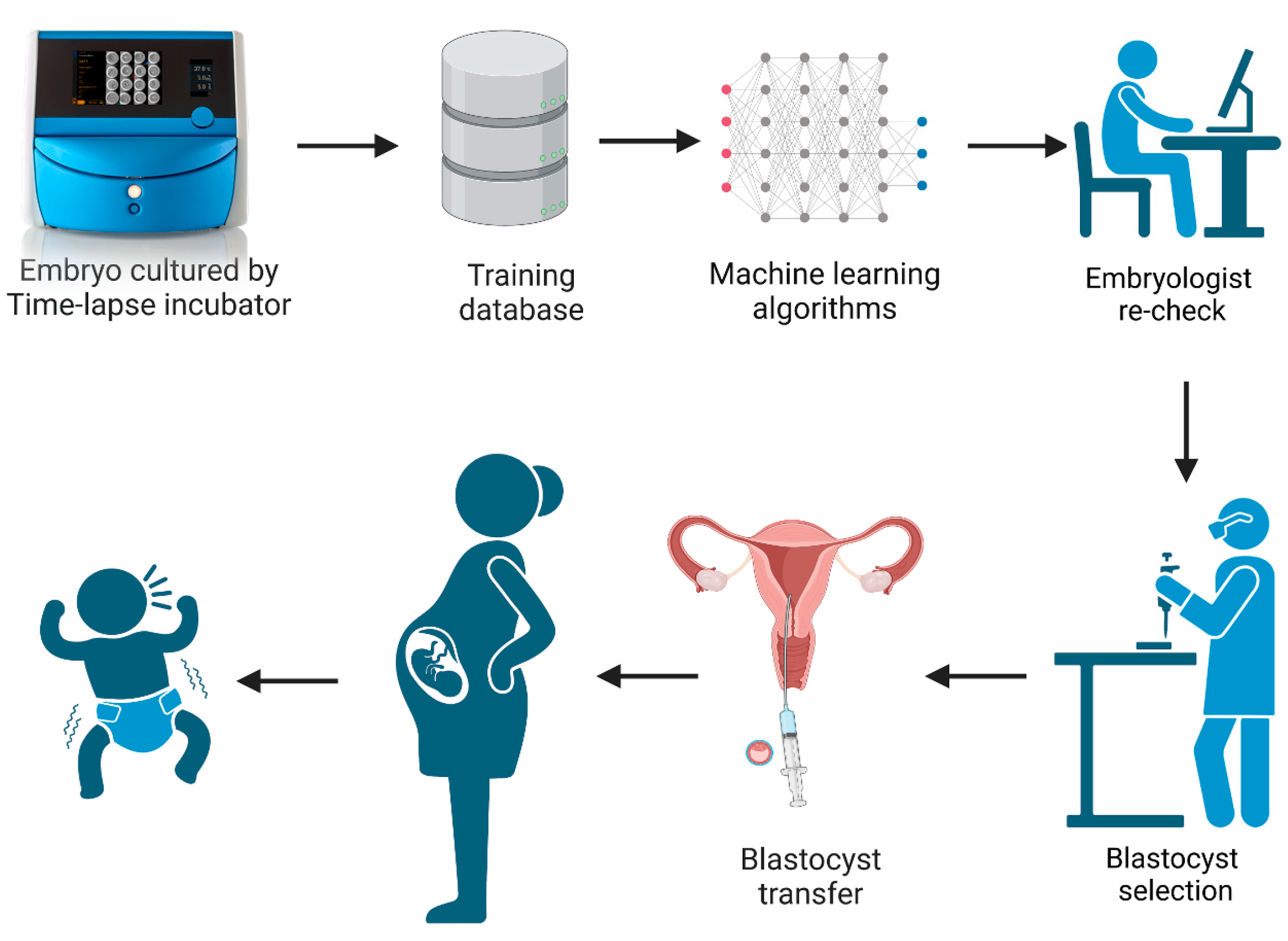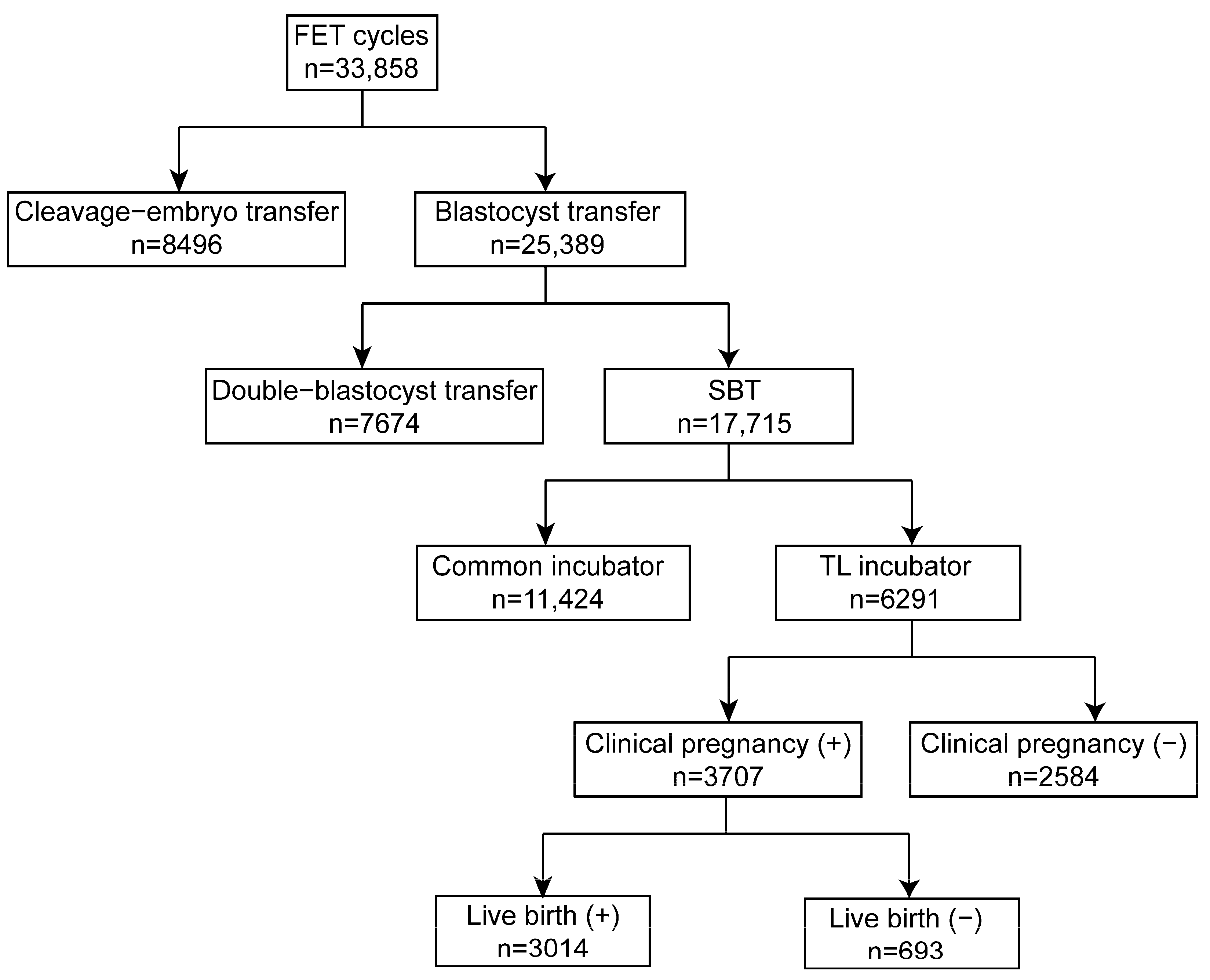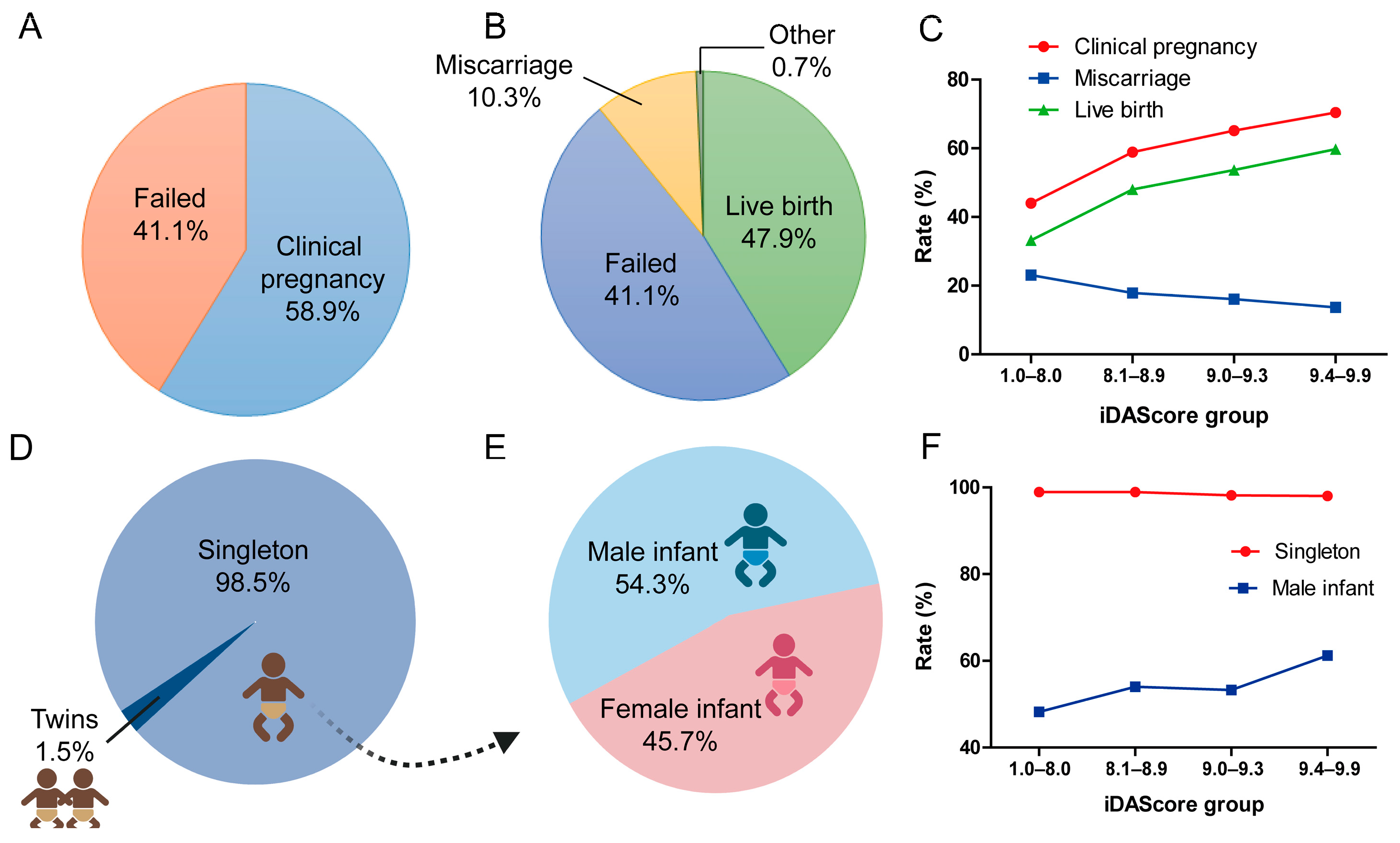Predictive Ability of an Objective and Time-Saving Blastocyst Scoring Model on Live Birth
Abstract
1. Introduction
2. Materials and Methods
2.1. Study Design
2.2. Clinical Protocol
2.3. Laboratory Protocol
2.4. FET Protocols
2.5. iDAScore Model
2.6. Statistical Analysis
3. Results
3.1. Patient Characteristics in Different iDAScore Groups
3.2. Clinical Outcomes of Blastocysts in Different iDAScore Groups
3.3. Perinatal and Neonatal Outcomes of Blastocysts in Different iDAScore Groups
3.4. Uni- and Multivariable Logistic Regression Analysis for LB
4. Discussion
5. Conclusions
Supplementary Materials
Author Contributions
Funding
Institutional Review Board Statement
Informed Consent Statement
Data Availability Statement
Acknowledgments
Conflicts of Interest
Abbreviations
| eSBT | Elective single blastocyst transfer |
| ICM | Inner cell mass |
| TE | Trophectoderm |
| COS | Controlled ovarian stimulation |
| HCG | Human chorionic gonadotropin |
| COCs | Cumulus–oocyte complexes |
| FET | Frozen embryo transfer |
| IVF | In vitro fertilization |
| ICSI | Intracytoplasmic sperm injection |
| LB | Live birth |
| OR | Odds ratio |
| IQR | Interquartile range |
References
- Kim, H.J.; Park, J.K.; Eum, J.H.; Song, H.; Lee, W.S.; Lyu, S.W. Embryo Selection Based on Morphological Parameters in a Single Vitrified-Warmed Blastocyst Transfer Cycle. Reprod. Sci. 2021, 28, 1060–1068. [Google Scholar] [CrossRef]
- Lin, J.; Zhao, J.; Hao, G.; Tan, J.; Pan, Y.; Wang, Z.; Jiang, Q.; Xu, N.; Shi, Y. Maternal and Neonatal Complications After Natural vs. Hormone Replacement Therapy Cycle Regimen for Frozen Single Blastocyst Transfer. Front. Med. 2020, 7, 338. [Google Scholar] [CrossRef]
- Gardner, D.K.; Lane, M.; Stevens, J.; Schlenker, T.; Schoolcraft, W.B. Blastocyst score affects implantation and pregnancy outcome: Towards a single blastocyst transfer. Fertil. Steril. 2000, 73, 1155–1158. [Google Scholar] [CrossRef]
- Shi, W.; Jin, L.; Liu, J.; Zhang, C.; Mi, Y.; Shi, J.; Wang, H.; Liang, X. Blastocyst morphology is associated with the incidence of monozygotic twinning in assisted reproductive technology. Am. J. Obstet. Gynecol. 2021, 225, 654.e1–654.e16. [Google Scholar] [CrossRef] [PubMed]
- Ma, B.X.; Zhang, H.; Jin, L.; Huang, B. Neonatal Outcomes of Embryos Cultured in a Time-Lapse Incubation System: An Analysis of More Than 15,000 Fresh Transfer Cycles. Reprod. Sci. 2022, 29, 1524–1530. [Google Scholar] [CrossRef] [PubMed]
- Sciorio, R.; Meseguer, M. Focus on time-lapse analysis: Blastocyst collapse and morphometric assessment as new features of embryo viability. Reprod. Biomed. Online 2021, 43, 821–832. [Google Scholar] [CrossRef] [PubMed]
- ESHRE Working group on Time-lapse technology; Apter, S.; Ebner, T.; Freour, T.; Guns, Y.; Kovacic, B.; Le Clef, N.; Marques, M.; Meseguer, M.; Montjean, D.; et al. Good practice recommendations for the use of time-lapse technology. Hum. Reprod. Open 2020, 2020, hoaa008. [Google Scholar] [CrossRef]
- Revelli, A.; Canosa, S.; Carosso, A.; Filippini, C.; Paschero, C.; Gennarelli, G.; Piane, L.D.; Benedetto, C. Impact of the addition of Early Embryo Viability Assessment to morphological evaluation on the accuracy of embryo selection on day 3 or day 5: A retrospective analysis. J. Ovarian Res. 2019, 12, 73. [Google Scholar] [CrossRef]
- Ebner, T.; Oppelt, P.; Radler, E.; Allerstorfer, C.; Habelsberger, A.; Mayer, R.B.; Shebl, O. Morphokinetics of vitrified and warmed blastocysts predicts implantation potential. J. Assist. Reprod. Genet. 2017, 34, 239–244. [Google Scholar] [CrossRef]
- Desai, N.; Goldberg, J.M.; Austin, C.; Falcone, T. Are cleavage anomalies, multinucleation, or specific cell cycle kinetics observed with time-lapse imaging predictive of embryo developmental capacity or ploidy? Fertil. Steril. 2018, 109, 665–674. [Google Scholar] [CrossRef]
- Berntsen, J.; Rimestad, J.; Lassen, J.T.; Tran, D.; Kragh, M.F. Robust and generalizable embryo selection based on artificial intelligence and time-lapse image sequences. PLoS ONE 2022, 17, e0262661. [Google Scholar] [CrossRef] [PubMed]
- Ueno, S.; Berntsen, J.; Ito, M.; Uchiyama, K.; Okimura, T.; Yabuuchi, A.; Kato, K. Pregnancy prediction performance of an annotation-free embryo scoring system on the basis of deep learning after single vitrified-warmed blastocyst transfer: A single-center large cohort retrospective study. Fertil. Steril. 2021, 116, 1172–1180. [Google Scholar] [CrossRef] [PubMed]
- Tran, D.; Cooke, S.; Illingworth, P.J.; Gardner, D.K. Deep learning as a predictive tool for fetal heart pregnancy following time-lapse incubation and blastocyst transfer. Hum. Reprod. 2019, 34, 1011–1018. [Google Scholar] [CrossRef] [PubMed]
- Ueno, S.; Berntsen, J.; Ito, M.; Okimura, T.; Kato, K. Correlation between an annotation-free embryo scoring system based on deep learning and live birth/neonatal outcomes after single vitrified-warmed blastocyst transfer: A single-centre, large-cohort retrospective study. J. Assist. Reprod. Genet. 2022, 39, 2089–2099. [Google Scholar] [CrossRef]
- Liu, Y.; Chapple, V.; Feenan, K.; Roberts, P.; Matson, P. Time-lapse deselection model for human day 3 in vitro fertilization embryos: The combination of qualitative and quantitative measures of embryo growth. Fertil. Steril. 2016, 105, 656–662.e1. [Google Scholar] [CrossRef]
- Petersen, B.M.; Boel, M.; Montag, M.; Gardner, D.K. Development of a generally applicable morphokinetic algorithm capable of predicting the implantation potential of embryos transferred on Day 3. Hum. Reprod. 2016, 31, 2231–2244. [Google Scholar] [CrossRef]
- Yang, L.; Cai, S.; Zhang, S.; Kong, X.; Gu, Y.; Lu, C.; Dai, J.; Gong, F.; Lu, G.; Lin, G. Single embryo transfer by Day 3 time-lapse selection versus Day 5 conventional morphological selection: A randomized, open-label, non-inferiority trial. Hum. Reprod. 2018, 33, 869–876. [Google Scholar] [CrossRef]
- Meseguer, M.; Herrero, J.; Tejera, A.; Hilligsoe, K.M.; Ramsing, N.B.; Remohi, J. The use of morphokinetics as a predictor of embryo implantation. Hum. Reprod. 2011, 26, 2658–2671. [Google Scholar] [CrossRef]
- Tokuoka, Y.; Yamada, T.G.; Mashiko, D.; Ikeda, Z.; Kobayashi, T.J.; Yamagata, K.; Funahashi, A. An explainable deep learning-based algorithm with an attention mechanism for predicting the live birth potential of mouse embryos. Artif. Intell. Med. 2022, 134, 102432. [Google Scholar] [CrossRef]
- Rubio, I.; Galán, A.; Larreategui, Z.; Ayerdi, F.; Bellver, J.; Herrero, J.; Meseguer, M. Clinical validation of embryo culture and selection by morphokinetic analysis: A randomized, controlled trial of the EmbryoScope. Fertil. Steril. 2014, 102, 1287–1294.e5. [Google Scholar] [CrossRef]
- Adamson, G.D.; Abusief, M.E.; Palao, L.; Witmer, J.; Palao, L.M.; Gvakharia, M. Improved implantation rates of day 3 embryo transfers with the use of an automated time-lapse-enabled test to aid in embryo selection. Fertil. Steril. 2016, 105, 369–375.e6. [Google Scholar] [CrossRef]
- VerMilyea, M.D.; Tan, L.; Anthony, J.T.; Conaghan, J.; Ivani, K.; Gvakharia, M.; Boostanfar, R.; Baker, V.L.; Suraj, V.; Chen, A.A.; et al. Computer-automated time-lapse analysis results correlate with embryo implantation and clinical pregnancy: A blinded, multi-centre study. Reprod. Biomed. Online 2014, 29, 729–736. [Google Scholar] [CrossRef]
- Kirkegaard, K.; Campbell, A.; Agerholm, I.; Bentin-Ley, U.; Gabrielsen, A.; Kirk, J.; Sayed, S.; Ingerslev, H.J. Limitations of a time-lapse blastocyst prediction model: A large multicentre outcome analysis. Reprod. Biomed. Online 2014, 29, 156–158. [Google Scholar] [CrossRef]
- Freour, T.; Le Fleuter, N.; Lammers, J.; Splingart, C.; Reignier, A.; Barriere, P. External validation of a time-lapse prediction model. Fertil. Steril. 2015, 103, 917–922. [Google Scholar] [CrossRef]
- Ezoe, K.; Shimazaki, K.; Miki, T.; Takahashi, T.; Tanimura, Y.; Amagai, A.; Sawado, A.; Akaike, H.; Mogi, M.; Kaneko, S.; et al. Association between a deep learning-based scoring system with morphokinetics and morphological alterations in human embryos. Reprod. Biomed. Online 2022, 45, 1124–1132. [Google Scholar] [CrossRef]
- Kato, K.; Ueno, S.; Berntsen, J.; Kragh, M.F.; Okimura, T.; Kuroda, T. Does embryo categorization by existing artificial intelligence, morphokinetic or morphological embryo selection models correlate with blastocyst euploidy rates? Reprod. Biomed. Online 2023, 46, 274–281. [Google Scholar] [CrossRef] [PubMed]
- Avery, B.; Madison, V.; Greve, T. Sex and development in bovine in-vitro fertilized embryos. Theriogenology 1991, 35, 953–963. [Google Scholar] [CrossRef] [PubMed]
- Mao, Y.; Zeng, M.; Meng, Y.M.; Wang, C.; Luo, Y.; Li, L. Effect of blastocyst quality on human sex ratio at birth in a single blastocyst frozen thawed embryo transfer cycle. Gynecol. Endocrinol. 2023, 39, 2216787. [Google Scholar] [CrossRef] [PubMed]
- Lou, H.; Li, N.; Zhang, X.; Sun, L.; Wang, X.; Hao, D.; Cui, S. Does the sex ratio of singleton births after frozen single blastocyst transfer differ in relation to blastocyst development? Reprod. Biol. Endocrinol. 2020, 18, 72. [Google Scholar] [CrossRef]
- Cai, H.; Ren, W.; Wang, H.; Shi, J. Sex ratio imbalance following blastocyst transfer is associated with ICSI but not with IVF: An analysis of 14,892 single embryo transfer cycles. J. Assist. Reprod. Genet. 2022, 39, 211–218. [Google Scholar] [CrossRef]
- Menezo, Y.J.; Chouteau, J.; Torello, J.; Girard, A.; Veiga, A. Birth weight and sex ratio after transfer at the blastocyst stage in humans. Fertil. Steril. 1999, 72, 221–224. [Google Scholar] [CrossRef]
- Ebner, T.; Tritscher, K.; Mayer, R.B.; Oppelt, P.; Duba, H.-C.; Maurer, M.; Schappacher-Tilp, G.; Petek, E.; Shebl, O. Quantitative and qualitative trophectoderm grading allows for prediction of live birth and gender. J. Assist. Reprod. Genet. 2016, 33, 49–57. [Google Scholar] [CrossRef]
- Gardner, D.K.; Wale, P.L. Analysis of metabolism to select viable human embryos for transfer. Fertil. Steril. 2013, 99, 1062–1072. [Google Scholar] [CrossRef] [PubMed]
- Epstein, C.J.; Smith, S.; Travis, B.; Tucker, G. Both X chromosomes function before visible X-chromosome inactivation in female mouse embryos. Nature 1978, 274, 500–503. [Google Scholar] [CrossRef] [PubMed]
- Tarin, J.J.; Garcia-Perez, M.A.; Hermenegildo, C.; Cano, A. Changes in sex ratio from fertilization to birth in assisted-reproductive-treatment cycles. Reprod. Biol. Endocrinol. 2014, 12, 56. [Google Scholar] [CrossRef] [PubMed][Green Version]
- Tan, K.; An, L.; Miao, K.; Ren, L.; Hou, Z.; Tao, L.; Zhang, Z.; Wang, X.; Xia, W.; Liu, J.; et al. Impaired imprinted X chromosome inactivation is responsible for the skewed sex ratio following in vitro fertilization. Proc. Natl. Acad. Sci. USA 2016, 113, 3197–3202. [Google Scholar] [CrossRef] [PubMed]
- Alfarawati, S.; Fragouli, E.; Colls, P.; Stevens, J.; Gutiérrez-Mateo, C.; Schoolcraft, W.B.; Katz-Jaffe, M.G.; Wells, D. The relationship between blastocyst morphology, chromosomal abnormality, and embryo gender. Fertil. Steril. 2011, 95, 520–524. [Google Scholar] [CrossRef]
- Bronet, F.; Nogales, M.-C.; Martínez, E.; Ariza, M.; Rubio, C.; García-Velasco, J.-A.; Meseguer, M. Is there a relationship between time-lapse parameters and embryo sex? Fertil. Steril. 2015, 103, 396–401.e2. [Google Scholar] [CrossRef]



| iDAScore Group | All | 1.0–8.0 | 8.1–8.9 | 9.0–9.3 | 9.4–9.9 | p Value |
|---|---|---|---|---|---|---|
| Cycles, n | 6291 | 1683 | 1556 | 1909 | 1143 | / |
| Maternal age, mean ± SD, year | 31.5 ± 4.2 | 31.9 ± 4.5 | 31.8 ± 4.1 | 31.2 ± 4.0 | 31.0 ± 4.2 | <0.001 a |
| Cryopreservation duration, median (IQR), day | 66 (31–146) | 86 (36–186) | 67 (31–140) | 62 (30–127) | 60 (29–116) | <0.001 b |
| Endometrial thickness | 9.4 ± 1.5 | 9.3 ± 1.5 | 9.4 ± 1.6 | 9.4 ± 1.5 | 9.4 ± 1.4 | 0.078 c |
| Regimen of endometrial preparation for frozen embryo transfer, n (%) | 0.208 d | |||||
| Natural cycle | 248 (4.0%) | 66 (3.9%) | 75 (4.8%) | 68 (3.6%) | 39 (3.4%) | |
| Programmed cycle | 5922 (94.1%) | 1583 (94.1%) | 1459 (93.8%) | 1804 (94.5%) | 1076 (94.1%) | |
| Others | 121 (1.9%) | 34 (2.0%) | 22 (1.4%) | 37 (1.9%) | 28 (2.5%) | |
| Length of incubation | <0.001 e | |||||
| Day 5 | 4706 (74.8%) | 440 (26.1%) | 1218 (78.3%) | 1905 (99.8%) | 1143 (100.0%) | |
| Day 6 | 1562 (24.8%) | 1220 (72.5%) | 338 (21.7%) | 4 (0.2%) | 0 (0.0%) | |
| Day 7 | 23 (0.4%) | 23 (1.4%) | 0 (0.0%) | 0 (0.0%) | 0 (0.0%) | |
| iDAScore Group | All | 1.0–8.0 | 8.1–8.9 | 9.0–9.3 | 9.4–9.9 | p Value |
|---|---|---|---|---|---|---|
| Live birth, n | 2968 | 552 | 739 | 1007 | 670 | |
| Gestational age, mean ± SD, weeks | 38.2 ± 1.6 | 38.2 ± 1.5 | 38.2 ± 1.7 | 38.3 ± 1.6 | 38.3 ± 1.6 | 0.707 a |
| Early preterm birth (<37 weeks), n (%) | 305 (10.3%) | 63 (11.4%) | 73 (9.9%) | 100 (9.9%) | 69 (10.3%) | 0.794 b |
| Very early preterm birth (<32 weeks), n (%) | 23 (0.8%) | 0 (0.0%) | 9 (1.2%) | 8 (0.8%) | 6 (0.9%) | 0.097 b |
| Types of pregnancy complication, n (%) | 0.645 c | |||||
| Gestational hypertension, n (%) | 60 (2.0%) | 10 (1.8%) | 20 (2.7%) | 18 (1.8%) | 12 (1.8%) | |
| Gestational diabetes, n (%) | 61 (2.0%) | 8 (1.4%) | 17 (2.2%) | 20 (2.0%) | 16 (2.3%) | |
| Pre-eclampsia, n (%) | 6 (0.2%) | 2 (0.4%) | 3 (0.4%) | 1 (0.1%) | 0 (0.0%) | |
| Placenta previa, n (%) | 33 (1.1%) | 5 (0.9%) | 7 (0.9%) | 13 (1.3%) | 8 (1.2%) | |
| Premature rupture of membranes, n (%) | 43 (1.4%) | 6 (1.1%) | 9 (1.2%) | 16 (1.6%) | 12 (1.8%) | |
| Birth weight, n (%) | 0.063 d | |||||
| <1500 g | 16 (0.5%) | 0 (0.0%) | 10 (1.4%) | 5 (0.5%) | 1 (0.0%) | |
| 1500–2499 g | 144 (4.9%) | 32 (5.8%) | 36 (4.9%) | 48 (4.8%) | 28 (4.2%) | |
| 2500–3999 g | 2602 (87.7%) | 484 (87.7%) | 644 (87.1%) | 883 (87.7%) | 591 (88.2%) | |
| ≥4000 g | 206 (6.9%) | 36 (6.5%) | 49 (6.6%) | 71 (7.0%) | 50 (7.5%) | |
| Univariable Analysis | Multivariable Analysis | |||||
|---|---|---|---|---|---|---|
| Odds ratio | 95 CI% | p value | Odds ratio | 95 CI% | p value | |
| iDAScore | 1.285 | 1.239–1.333 | <0.001 | 1.200 | 1.148–1.253 | <0.001 |
Disclaimer/Publisher’s Note: The statements, opinions and data contained in all publications are solely those of the individual author(s) and contributor(s) and not of MDPI and/or the editor(s). MDPI and/or the editor(s) disclaim responsibility for any injury to people or property resulting from any ideas, methods, instructions or products referred to in the content. |
© 2025 by the authors. Licensee MDPI, Basel, Switzerland. This article is an open access article distributed under the terms and conditions of the Creative Commons Attribution (CC BY) license (https://creativecommons.org/licenses/by/4.0/).
Share and Cite
Ma, B.-X.; Zhou, F.; Zhao, G.-N.; Jin, L.; Huang, B. Predictive Ability of an Objective and Time-Saving Blastocyst Scoring Model on Live Birth. Biomedicines 2025, 13, 1734. https://doi.org/10.3390/biomedicines13071734
Ma B-X, Zhou F, Zhao G-N, Jin L, Huang B. Predictive Ability of an Objective and Time-Saving Blastocyst Scoring Model on Live Birth. Biomedicines. 2025; 13(7):1734. https://doi.org/10.3390/biomedicines13071734
Chicago/Turabian StyleMa, Bing-Xin, Feng Zhou, Guang-Nian Zhao, Lei Jin, and Bo Huang. 2025. "Predictive Ability of an Objective and Time-Saving Blastocyst Scoring Model on Live Birth" Biomedicines 13, no. 7: 1734. https://doi.org/10.3390/biomedicines13071734
APA StyleMa, B.-X., Zhou, F., Zhao, G.-N., Jin, L., & Huang, B. (2025). Predictive Ability of an Objective and Time-Saving Blastocyst Scoring Model on Live Birth. Biomedicines, 13(7), 1734. https://doi.org/10.3390/biomedicines13071734





